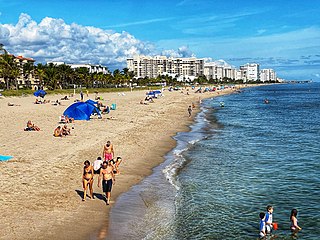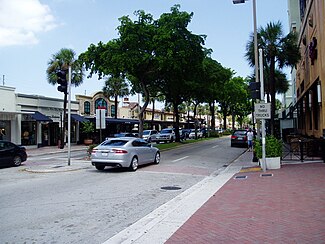
Broward County is a county in the southeastern part of Florida, located in the Miami metropolitan area. It is Florida's second-most populous county after Miami-Dade County and the 17th-most populous in the United States, with 1,944,375 residents as of the 2020 census. Its county seat and largest city is Fort Lauderdale, which had a population of 182,760 as of 2020.

Fort Lauderdale is a coastal city located in the U.S. state of Florida, 30 miles (48 km) north of Miami along the Atlantic Ocean. It is the county seat of and largest city in Broward County with a population of 182,760 at the 2020 census, making it the tenth largest city in Florida. After Miami and Hialeah, Fort Lauderdale is the third largest city in the Miami metropolitan area, which had a population of 6,166,488 in 2019.

Lauderdale-by-the-Sea is a town in Broward County, Florida, United States, situated 33 miles north of Miami. The town is part of the South Florida metropolitan area. As of the 2020 census, the population was 6,198.

South Beach, also nicknamed colloquially as SoBe, is a neighborhood in Miami Beach, Florida. It is located east of Miami between Biscayne Bay and the Atlantic Ocean. The area encompasses Miami Beach south of Dade Boulevard.

State Road A1A (SR A1A) is a major north–south Florida State Road consisting of seven separate sections running a total of 338.752 miles (545.168 km) along the Atlantic Ocean, from Key West at the southern tip of Florida, to Fernandina Beach, just south of Georgia on Amelia Island. It is the main road through most oceanfront towns. Part of SR A1A is designated the A1A Scenic and Historic Coastal Byway, a National Scenic Byway. A portion of SR A1A that passes through Volusia County is designated the Ormond Scenic Loop and Trail, a Florida Scenic Highway. It is also called the Indian River Lagoon Scenic Highway from State Road 510 at Wabasso Beach to U.S. Route 1 in Cocoa. SR A1A is famous worldwide as a center of beach culture in the United States, a scenic coastal route through most Atlantic coastal cities and beach towns, including the unique tropical coral islands of the Florida Keys. SR A1A also serves as a major thoroughfare through Miami Beach and other south Florida coastal cities.
The Millionaires' Mile, Millionaires' Row, Billionaires Row, Golden Mile or Alpha Street are the exclusive residential neighborhoods of various cities, often along one scenic strip such as a riverside or hilltop drive, or a wide city boulevard.

Dixie Highway in Palm Beach and Broward counties carries two segments of the State Road 811 designation by Florida Department of Transportation, as well as the local County Road 811 in southeast Florida. The entire road comprises a section of the Dixie Highway, a National Auto Trail which eventually became a former routing of U.S. Route 1 after the route was shifted east to Federal Highway. One segment of SR 811 is in Broward County and the other is in Palm Beach County, Florida. The segments of SR 811 are supplemented by three shorter segments of CR 811, one of which is unsigned.

Broward Boulevard is an 11.766 miles (18.936 km) long major east–west thoroughfare through Broward County, Florida, mostly designated State Road 842 (SR 842). The western terminus is an intersection with Commodore Drive in Plantation, and it continues east to U.S. Route 1 (US 1) in Fort Lauderdale. The westernmost 5.4 miles (8.7 km) is designated as County Road 842, and is seldom signed as such.

State Road 858, known locally as Hallandale Beach Boulevard, is a 5.429-mile-long (8.737 km) divided highway in southern Broward County, Florida. Its western terminus is an intersection with U.S. Route 441 at the border between Miramar and West Park; its eastern terminus is an intersection with South Ocean Drive on the boundary between Hallandale Beach and Hollywood, just east of the Intracoastal Waterway. SR 858 is the latitudinal baseline for Hallandale Beach's street grid.

County Road 707 (CR 707) is a designation applied to two segments of road across three counties on Florida's Treasure Coast. The entire road was formerly designated State Road 707 (SR 707) and has been gradually transferred to county jurisdiction.

Commercial Boulevard is a 15.2-mile-long (24.5 km) highway serving northern Broward County, Florida, mostly designated as State Road 870 (SR 870). The road extends from its western terminus in Sunrise at SR 869, the Sawgrass Expressway, and serves as a major commercial route through Oakland Park, and Fort Lauderdale, intersecting Florida's Turnpike, U.S. Route 441 (US 441), Interstate 95 (I-95) and US 1 before reaching its eastern terminus at SR A1A in Lauderdale-by-the-Sea, Florida.

Sunrise Boulevard is a 15.6 miles (25.1 km) long east–west highway serving central Broward County mostly designated State Road 838. The road begins at an interchange with the Sawgrass Expressway in Sunrise and continues east to North Ocean Boulevard in Fort Lauderdale, next to Hugh Taylor Birch State Park. For 0.91 miles (1.46 km) in downtown Fort Lauderdale, SR 838 overlaps U.S. Route 1.

State Road 816, locally known as Oakland Park Boulevard is a 13.420-mile-long (21.597 km) east–west commercial and commuter road serving central Broward County, Florida, carrying the designations of State Road 816 (SR 816) and County Road 816 (CR 816). It extends from the Sawgrass Expressway east to an intersection with SR A1A in Fort Lauderdale.

James T. Naugle is an American real estate broker who served as mayor of Fort Lauderdale, Florida. Although a lifelong Democrat, Naugle frequently voted for and supported Republican candidates. Elected for the first time in 1991, Naugle was the longest-serving mayor in the history of Fort Lauderdale, serving for six consecutive terms.
The history of Fort Lauderdale, Florida began more than 4,000 years ago with the arrival of the first aboriginal natives, and later with the Tequesta Indians, who inhabited the area for more than a thousand years. Though control of the area changed among Spain, England, the United States, and the Confederate States of America, it remained largely undeveloped until the 20th century. The first settlement in the area was the site of a massacre at the beginning of the Second Seminole War, an event which precipitated the abandonment of the settlement and set back development in the area by over 50 years. The first United States stockade named Fort Lauderdale was built in 1838, and subsequently was a site of fighting during the Second Seminole War. The fort was abandoned in 1842, after the end of the war, and the area remained virtually unpopulated until the 1890s.
The Seven Isles neighborhood comprises 315 households, with approximately 1,145 residents, and is situated north of Las Olas Boulevard. The Intracoastal Waterway borders the east and north boundaries, while the neighborhoods of Sunrise Key and Sunrise Intracoastal are to the north, the neighborhood of Central Beach is east of it, the neighborhoods of Idlewyld and Riviera Isles are to the south, Las Olas Isles is located southwest of it, and the neighborhood to the west of the Intracoastal Waterway is Nurmi Isles. There are nine streets within the Seven Isles: Aqua Vista Boulevard, Barcelona Drive, Castilla Isle, Del Mar Place, De Sota Drive, De Sota Terrace, Pelican Isle, Sea Island Drive and Seven Isles Drive.

Riverwalk, also known as the Fort Lauderdale Riverwalk, is a riverwalk along New River in Fort Lauderdale, Florida. Its length is over a mile and goes from the Sailboat Bend neighborhood to near the Stranahan House. It is in the former club district in downtown Fort Lauderdale. There are two main streets that run through the district, Las Olas Boulevard and Himmarshee Street.

The Elbo Room is a bar that was established in 1938 at 241 South Fort Lauderdale Beach Boulevard, Fort Lauderdale, Florida and that became a landmark for Fort Lauderdale Beach. The bar was featured in the 1960 film Where the Boys Are. Its location at the corner of Las Olas Boulevard places it on one end of the Fort Lauderdale strip. It is well-known for being the host of multiple surfing and boogie boarding championships in the late 1980s and early 1990', and a boogie-boarding competition won by Jason Goodman in 1988 was the signature event during this time period. The Penrod family purchased it in 1981.
The following is a timeline of the history of the city of Fort Lauderdale, Florida, USA.















